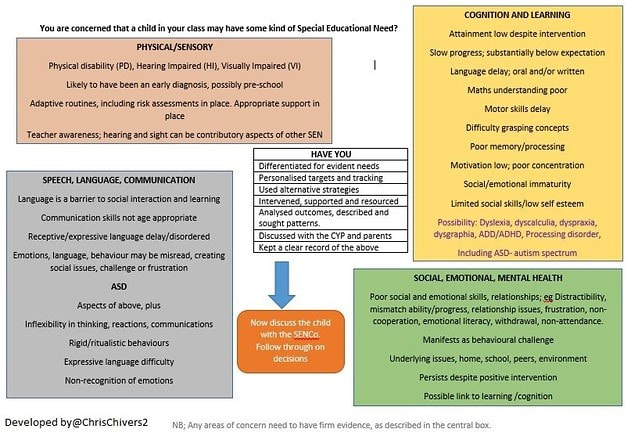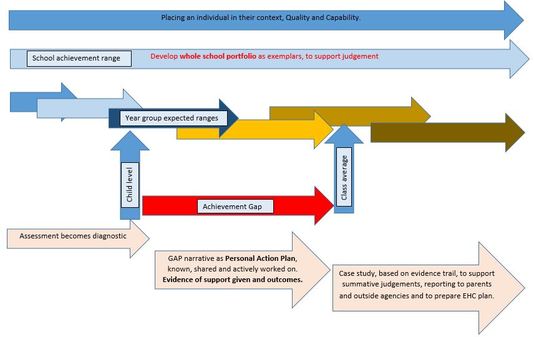There are four areas of SEN description in the 2014 framework
- Communication and Interaction
- Cognition and Learning
- Social, Emotional and Mental Health
- Sensory and/or Physical needs.
A very few will arrive with an Education Health and Care Plan, EHCP, in place, with specific needs identified and methodologies and support required for them to achieve the needs. This may, or may not, include some statement of dedicated teaching time or adult support.
Others will already be highlighted on the school SEN register, with earlier needs identified. That these last two groups are known ahead of time allows the receiving teacher to prepare and plan, anticipating their ongoing need within the class plans.
There may well be some children whose needs only become apparent during the new academic year. This could be as a result of external trauma, resulting in unexpected responses to learning situations, or it could be an unspotted earlier need that becomes apparent as challenges become harder to accommodate.
If, after a couple of weeks back in class, with new children, one or two are causing some unforeseen concern, it is important that every class teacher and additional adult recognises their place as front-line eyes and ears of T&L need.
Changes to the organisation of SEND provision have been in train for the past few years, during which time I have blogged, as I have come across useful information. These blogs are archived within my blog, see Contents but I will refer to aspects to provide an introduction.
In this post, I am not looking to describe the range of individual needs that might be encountered. There are many expert colleagues who are much more able to offer insights into the specifics of individualised SEN(D). I have focused on issues as they affect mainstream school teachers, which can be summarised as developing a coherent, investigative approach that can fit with normal classroom practice, which is premised on the need to look, to reflect and record concerns to inform deeper conversations.
SEN is an area of teaching and learning where teacher expertise can easily be challenged.
A feeling of vulnerability, identifying a personal need can create a tension. There is always the possibility of meeting a child whose needs fall outside previous experience; the truism that “you’ve met one child with autism, so you’ve met one child with autism” can exemplify many areas of SEN.
For known needs, it is essential that earlier information is available, read and planned to be actioned within the new class organisation, and where needed, specific advice sought, considered and planned.
With any new class, there is a period of what I would call “calibration or sometimes recalibration”, the teacher challenge in learning being more generic, based on earlier reading of records and possibly earlier experiences with that year group. Outcomes show greater detail “in the moment”, resulting in more tailored responses, questioning and feedback/guidance. Outcomes also enable finer tuning of challenge levels and responses, as individual needs become apparent.
On entry into the formal learning situation, the staff eyes and ears should be alert to issues, noting down things that are said and done, to ensure that future reflections can be based on pattern finding or evidence across a range of issues. Evidence finding is the bread and butter of teacher life, in terms of interactions, questioning, feedback, support and outcomes.
General statements like, “x cannot read”, are unhelpful to discussion.
Investigating and sharing specifically what a child can and cannot do can lead to focused intervention, rather than general approaches. Leaving a child in a situation where they are clearly failing, are seen to be failing and knowing that this is the case, is destructive to the child and to the teacher. Acknowledging specific issues and seeking the specific means to address the issues demonstrates a positive, professional approach.
There is no doubt that, when a teacher encounters a child who does not fit the “normal mould” that they are used to, that they may experience unease. Once a child enters school, it is less likely that concerns about potential special needs will be unknown, raised by parents or professionals, which hopefully have been followed up and investigated, so that, by the time a teacher encounters the child there may already be records with substantial supportive information available.
The journey to SEN decisions is likely to be a phased affair, especially with regard to learning issues and possibly over an extended timescale for many children, much to the frustration of parents and teachers.
“Getting a handle” on the problem can be a case of more structured investigation that may eventually lead to diagnosis, prescription and deciding on courses of action.
It is really important that teachers and other adults in class note down their concerns, from their earliest awareness, so that timely discussion with professional colleagues can distil patterns, suggest alternative courses of action and also avoid delay should there be a need to refer to an external form of support, eg the school Educational Psychologist (EP). Unless there is a track record of concern, the EP may well request that the classteacher undertakes activities that have already been tried, but the outcomes not recorded. This can add to unnecessary delays in addressing key issues.
Action is also embedded in classroom relationships and these need to be carefully considered. All children need teacher time, as they are the key strategic decision maker.
Children seem to know where they are in comparison with their peers. They can judge for themselves those who can achieve in an area and can also highlight what they can’t achieve, across a wide range of subjects. This can lead to self-esteem issues, to go along with their understanding of a learning struggle. Children know when they are being given easier things to do, so presenting appropriately challenging activities, with commensurate scaffolded support is important. Allocating a teaching assistant to an issue can create a mutually dependent relationship, with a child’s independence and decision-making capacity being limited by constant adult support. It needs careful oversight and review.
The children with the greatest need, need the best teaching.
The class teacher must teach these groups or individuals, to ensure quality teaching is available to them and also to deepen their understanding of the child(ren)’s needs.
Where this is the case, reference to teachers of earlier years can provide pedagogical and practical advice. In many ways, teaching standard 2, progress and outcomes, is THE key standard to support teacher understanding. What is the anticipated learning journey of children from early years through to year 6? While we know that learning is never linear, concerns about a child’s learning is often judged against such an expectation.
This crib sheet at the header might support record collection and prepare the ground for discussion. The centre box suggests an approach.
So, from a classroom perspective, I’d offer the following:-
· Start a RADIO* file on individuals who are raising worries. *Record of Actions, Discussions or Decisions, Interventions and Outcomes.
· Annotate plans regularly with individual concerns.
· Annotate exercise books with appropriate supportive commentary.
· Make diary notes in the RADIO file to deduce any pattern arising.
· All adults become “spotters”. Keep a post it note record of things that happen in the lesson, to add to the RADIO. Ask any support adults to do the same.
· The record should allow the teacher to create a proper narrative, with action, outcome and judgements/decisions, refined actions. There should be a record of planning adaptation.
At this point, the class teacher can take the beginnings of a case study to the SENCo, thus avoiding the generic conversation that starts, “X has a problem with…” or “Y just doesn’t get it…” which then needs to go through the process outlined above. By adopting this approach early, and similar systems are embedded in many schools, valuable time for vulnerable learners is saved.
Neither the class teacher, nor the SENCo is not being asked to be a diagnostician, but an investigator and describer of learning, behaviours and outcomes. The TA or other adult support can provide additional insights into issues. The broadest view available will support decision making.
Stepping up a notch.
If the teacher has got to the point where the child’s needs exceed their expertise or experience, they may feel the need to involve another adult, an experienced colleague such as the SENCo, to seek advice and solutions. There is nothing wrong in saying that you need help with a specific child’s needs. By asking for advice, broader school awareness is raised.
This stage was previously called School Action (Plus), and may involve deeper exploration of the issues supported by a range of external expertise, all of which will be subject to reports to the school, enhancing the available evidence.
I’d expect some kind of agreed internal plan to be developed, with the focus on actions, from the teacher, to seek to effect specific change; to keep a further diary of interventions, and outcomes, over relatively short timescales. These Personal Action Plans need to be seen embedded in plans and visible in practice. They should be clear descriptors, accessible and shared with parents at each stage. The focus on classroom action is essential. Progress should be capable of being measured in some form. They were called Individual Education Plans, IEPs, but could sometimes appear to be disregarded in practice.
Regular reviews and refinements eventually build to a more substantial case study file, which is likely to be then supported with reports from a range of additional professionals.
These files start with the teacher spotting and recording needs over a time scale, investigating anomalies, so that the support systems around them can offer advice based on detail.
That’s teaching…
SEND is often linked to Inclusion practice
Inclusion can sometimes be seen as an add-on to “normal” teaching activity.
It is possible to argue that inclusion, far from being an add-on,
is an integral part of practice,
explicit in the detail of the standards for teachers.
Teachers will go to work each day to secure the best opportunities
for each and every child in their class.
Inclusion occurs in the best of teaching experiences.
Inclusion is not something that is done to people.
It is an aspect of ethos, a principle and, as such, exists or it doesn’t.
An inclusive environment is one where people matter,
their needs and aspirations are not only known but are also supported.
Therefore, it is a college of individuals which cares for each other,
the collegiate approach.
Inclusion is an ethos based on love and care,
with the opposite extreme leading to exclusion and a child being ostracised.
An inclusive ethos should allow individuals to express themselves
and, at times, to articulate different opinions.
Openness and articulacy can support the resolution of issues more easily.
Inclusive organisations often support discussion and resolution
through mediation and allowing advocacy for vulnerable members.
All school staff are the eyes and ears of the organisation.
In this approach, early identification of concerns,
such as behaviour change, physical hurt and absence
can lead to early intervention, by the most suitable means,
sometimes external to the school.
School staff have a responsibility to keep children safe.
Intervention can be testing for the adult,
but to ignore warning signs puts everyone at risk.
Every child is unique, demonstrably so, educationally,
physically, emotionally, socially, though heritage and life experience.
It is possible to perceive thirty different needs in a class of thirty children.
That puts a strain on a teacher’s organisational abilities
and their ability to engage with each individual.
However, differentially challenging activities can lead to deeper engagement
with small groups and individuals, where whole class teaching cannot.
Differentiation has been a significant challenge to teachers,
as it implies the need to plan for several layers of ability within groups.
Some schools organise in sets or streams, but it is arguable that even in sets there
is a continuum of ability, even if it is narrowed.
One only has to ask the simple question, “What’s the point in being bright in this classroom?”
to see that some may not be sufficiently challenged.
Challenge implies expectation,
where the teacher has analysed the child’s needs and can see what that the next
learning step is.
Expectation can lead to aspiration,
with targets being set slightly higher, but with support.
Teachers need to be aware that task
completion does not automatically mean success in learning,
but the combination of learning processes with positive outcomes is energising
to both the child and the teacher.
We all want the “light-bulb moment”.
Inclusion should imply personalised approaches to learning and teaching,
with individualised challenges for children
to enable them to become engaged learners and active producers,
rather than consumers.
Assessment, analysis and reflection are embedded within practice,
supporting individual and institutional progress.
The mantra for each school and each individual within a school should be,
“Inclusion is what we do.”
More reading?
Practical SEN(D) Linking ideas into a coherent whole.
SEND 2014; possible class teacher Crib sheet.


 RSS Feed
RSS Feed
